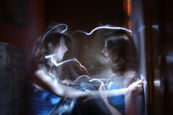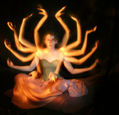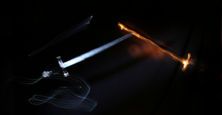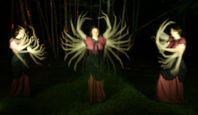Sean P.
From mediaartiststudio
Contents |
[edit] Experimental Third-Dimension Light Painting Film Project [working title]
Light painting − the process of taking a long-exposure photograph in a darkened area while selectively lighting elements with a flashlight − is a photographic technique that can be traced back as far as 1924 (when Pablo Picasso drew a quick sketch in an image with a handheld light source), and perhaps further. However, this technique is not widely known, and it has only recently been adapted for use in animation. In the eyes of many artists, it is in its infancy. With my winter and spring project, I hope to make some bold steps forward with light painting in film.
The storyline/concept of the piece revolves around a silent protagonist who enters a surreal world through dreaming. In this strange, dark, and foreboding place, he is alone aside from his flashlight, the only object that has carried over from the real world. When he turns it on, unusual light entities begin swarming out from within, and snatch away the flashlight, carrying it off into the woods. With nowhere else to go, the hero follows a trail of surreal illuminated destruction the light has brought upon the world as he tracks down his flashlight, seemingly the only means of controlling anything in this unfamiliar place. Before long, he is confronted by three of the world’s inhabitants, one at a time, who have been corrupted by the light and use light painting as a malevolent force. One chases the protagonist through the forest where he has set up traps made from light, another uses light painting to animate and guide a sword in battle with the protagonist, and the last uses light painting to augment and modify their own body. When the protagonist manages to outwit and defeat his enemies and regain his flashlight, he wakes up back in his world once again, but his flashlight retains the abilities it had in the dream world. He ponders the power he now has, and begins light painting as the credits start to roll.
The film is to have no dialogue and contain subtle elements of a twisted fairy-tale structure, while turning the classic idea of light=good, shadow=bad around, where the light represents an unfamiliar entity that spreads like a virus through a dark, ambiguous world. To accomplish my vision for the piece, I intend to create my own light painting techniques.
[edit] New Light Painting Techniques
Much of the animated light painting I've seen is rather basic, with light being shined into the camera lens and “drawn” with to achieve what is often referred to as "light graffiti." The sense of depth is often flat, as background and foreground elements are seldom acknowledged. Additionally, as far as motion is concerned, the movement of the light is usually shaky and abrupt, often because the light sources are handheld and lack real-world reference points to draw off of, which causes a lack of stability required to create more subtle motions. A recent solution for many of these problems has been through utilizing computer-generated mimicry of light painting, which gives the added benefit of being able to place the composited light painting layer into any video source, which allows for achieving a light graffiti aesthetic in a non-darkened area. However, I'm not interested in simulating a process, and I've found that the true dynamics of light painting stretch far beyond graffiti. My goals in this project are to accomplish things I haven't seen in light painting animation before. Rather than just shining light into the camera, I want to adapt the lesser-used technique of lighting subjects in front of the camera for animation. By lighting people, environments, and objects (all in a darkened area), and combining it with light graffiti, I want to create beautiful, surreal imagery that has previously only been seen in still form.
The way I'd like to advance light graffiti is to use flexible models made of wire to form the underlying structure of the light, which will then be outlined by flashlights (thus causing the wireframe to disappear from the image). These models can then be bent, twisted, added to, and otherwise animated by hand for each frame to result in a complex, smoothly flowing image with a degree of tangibility − something that has not been done with current light painting techniques.
I also plan on adding a large amount of animated camera movement. Since this is a frame-by-frame creation process, I plan on experimenting with dynamic camera movement techniques that wouldn't be possible (or would be very difficult to implement) in film & video. Lastly, to ensure smooth motion of the piece, I want to shoot the frame-rate as high as possible given the time I have. Ideally, each photograph would translate to one frame of video, though the extreme number of images required for such a process (9000 highly complex images for five minutes of motion) may require me to tone it down. I will likely shoot a good portion of the project at 15 fps.
There will also be a fair amount of the film shot on video, mostly for the beginning and ending sequences (the "reality" scenes) and for scenes of the protagonist when not interacting with light (walking, running, etc.). Due to the sheer number of light painting shots in the film, I will use video whenever possible, though careful attention will be paid to the lighting to ensure a consistent look between the two styles.
[edit] Additional Project Goals
- To do as much work as possible in-camera, with a minimum of computer processing of imagery aside from a large amount of color correction),
- To integrate video sequences into the project (thus highlighting the artistic differences during light painting segments), and to composite certain video segments into the light painting (an exception to the previous project goal, as it will require AfterEffects or another similar compositing program),
- To present the film in 1080p HD resolution,
- To have a dynamic, primarily acoustic original soundtrack,
- To mix the audio for surround sound.
[edit] Light Painting Examples
The following images are of light painting that Harmony Lawrence (a collaborator on the piece) and I have worked on together over the past year, using some of the same techniques that I hope to put into motion in this project.
[edit] Preliminary Production Schedule
[edit] Winter
Winter Break: Gather materials, construct wireframe models, test techniques, work on writing and storyboarding.
Week 1: Continue to gather materials, finish writing and wrap up storyboarding for upcoming scenes. Begin finding facilities to use for indoor shooting (The COM building has many possible rooms, as well as the photo studio in the library). Finalize casting.
Week 2: Begin production. Shoot intro and epilogue video sequences.
Week 3 – 10: Shoot the main portion of the project (switch over to still photography). During daylight hours, or when weather is bad, indoor sequences will be filmed. Otherwise, work on forest sequences. Do editing/post-production between shooting days. Start writing music for completed scenes as they come.
[edit] Spring
Week 1 – 5: Complete the principal photography, with an emphasis on forest scenes.
Week 6: Heavy sound and music design. Gather and record ambient noise, foley effects, etc. and process them.
Week 7 – 10: Take care of any unfinished photography. Primary focus should be on color correction, surround mixing, and finishing the music composition, as well as optimizing the project for HD, SD, stereo sound, and surround sound variations. Burn a Blu-ray disc of the full HD version.
[edit] Equipment
I have recently purchased a Canon EOS 5D Mark II (capable of shooting 21 megapixel photos as well as 1080p HD video) for the purposes of shooting the entire project on for both the video scenes and stop-motion animation. I have a sturdy tripod that the camera will always be attached to except for a few shots in the video portion that will involve some special rigs to achieve interesting camera movement (mostly from a small, makeshift crane). A large variety of filters and lenses (wide angle, telephoto, macro, and others) will be utilized for the piece.
The remainder of the equipment primarily consists of a variety of lighting sources, including:
- Flashlights (of various colors, primarily with warm & cool tones)
- Candles (mainly for use as props, but could also add an interesting effect to light painting)
- Strikers (science equipment for lighting gas - creates nice sparks)
- LEDs (used to create more detailed, smaller-scaled lighting and graffiti)
Lastly, I will be using a very large amount of wire for constructing the frames for the light graffiti.
Post-production will be completed using AfterEffects for compositing, Peak and Digital Performer for audio cleaning and mixing, and Final Cut Pro for assembly, color correction, and output.
[edit] Collaboration
For anyone who is interested in assisting with this project, I can definitely utilize additional help with light painting, as the more people there are on set, the faster the process can go. Outdoor scenes would have to be filmed late at night, but indoor sequences could be shot at any time of day if timing is an issue. I also may have slots open in the casting if anyone is interested in appearing in the project.
In addition to the light painting project, I will be helping James Kupihea with his romantic-comedy film as the cinematographer/director of photography and cameraman. My schedule, level of involvement and availability to work on his project will depend on the progress of my own project, but I hope to work with him on a majority of his film.
I will also be assisting Kamaria with The Greener Pastures as a technical consultant and to help with some of the editing of the show.
My availability to work on other projects is limited, but I would be glad to assist anyone in need of help in the post-production stage for editing or music composition.









